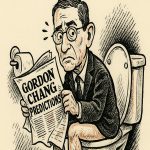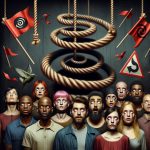Biggest Stock Market Drops in History—and the Opportunities They Left Behind
April 11, 2025
To know what you know and what you do not know, that is true knowledge. But to use that against the masses—that is power.
Crashes don’t kill portfolios. Emotional illiteracy does. Every great market collapse is an X-ray for investor psychology. Most panic. Most freeze. The rest? They adapt, they profit, and they conquer.
1929: The Original Shockwave
The Roaring Twenties ended not with a whimper but with a 12-gauge blast to the temple. Black Tuesday, October 29, 1929, saw the Dow lose over 12% in a single session. The collapse continued until 1932, wiping out nearly 90% of market value. What caused it? A cocktail of margin debt, blind optimism, and mass delusion.
The Tactical Investor’s Burro Theory applies perfectly here: the masses (the burros) were led to believe stocks only go up. They bought into a fantasy, just like they always do when consensus becomes gospel. Then came the punishment.
Technical Exit: Long before the floor fell out, there were warnings. Volume divergences on the Dow Industrials vs. the Transports. Triple-top formations in 1929 screamed distribution. The smart money was quietly heading for the exits.
Psychological Cue: Magazine covers heralded a new era of prosperity. Shoe shiners and taxi drivers gave stock tips. That wasn’t euphoria; it was mass psychosis.
Opportunity Missed: Those who didn’t freeze could have rotated into cash or gold. And those with courage bought the ashes in 1932—1933, when FDR’s New Deal injected hope and capital. That was a generational buy signal.
1973–74: The Oil Embargo Bloodletting
The S&P dropped nearly 50% over 21 months. High inflation, collapsing earnings, and an energy crisis triggered panic. But beneath the wreckage, new industries prepared to emerge.
Technical Exit: The death cross—when the 50-day MA crosses below the 200-day—flashed early in 1973. RSI stayed oversold for weeks, a rare sign of prolonged distribution.
Psychological Cue: Everyone became an inflation expert. Panic selling overtook logic. Fund flows reversed dramatically as investors fled into bonds.
Burro Theory in Action: Investors dumped tech and bought oil companies after they had already doubled. Chasing yesterday’s hero is the classic burro move.
Opportunity Missed: Intel and Texas Instruments traded at garage sale prices. A prescient few loaded up. Their portfolios told a different story a decade later.
1987: The Flash Before Flash Crashes
October 19, 1987. Black Monday. The Dow plunged 22% in a single day. No war. No pandemic. Just algorithms, fear, and mass herd behavior.
Technical Exit: The crash looked sudden but had a build-up: a non-confirmation between the Dow and broader indices, extreme RSI divergences, and an exploding put/call ratio. The walls were cracking before they crumbled.
Psychological Cue: Overconfidence. Market newsletter sentiment was over 90% bullish days before the collapse. The chart screamed caution, but the herd had its blinders on.
Opportunity Missed: Those who followed the chart instead of the cheerleaders saw SPX bounce 20%+ within weeks. A generational buying opportunity wrapped in blood and smoke.
2000: Dot-Com Implosion
The NASDAQ fell 78% from 2000 to 2002. Hype replaced profits. Pets.com had a Super Bowl ad but no earnings. Valuations lost tether to reality.
Technical Exit: Diverging MACD lines and triple tops on the NASDAQ were blatant. Insiders were dumping stock as retail bought in droves.
Psychological Cue: Mass belief that “this time it’s different.” The Internet would rewrite the economy—true in part, but not for every garbage IPO with a URL.
Burro Theory Redefined: Burros bet on rocket ships with no fuel. They mocked value investors. The crash taught them gravity never changes.
Opportunity Missed: Amazon dropped below $10, leaving Apple for dead. Smart contrarians saw the survivors of the wreckage and bought.
2008: The Global Financial Exorcism
Lehman fell, banks imploded, and SPX lost over 50%. The system broke—or so it seemed.
Technical Exit: Bearish wedges, rising volume on down days, and multi-timeframe RSI breakdowns signaled something foul long before Lehman blew.
Psychological Cue: The masses demanded bailouts while selling everything. They were victims of their greed—having chased real estate with borrowed money.
Opportunity Missed: March 2009 saw the VIX at a generational peak. Buffett bought. The SPX nearly tripled in five years. Charts and sentiment were aligned: extreme panic equals asymmetric upside.
2020: The Pandemic Panic
A 34% drop in 33 days. The fastest in history. Virus + lockdown = market cardiac arrest.
Technical Exit: RSI divergences and parabolic price exhaustion warned of reversal. When the SPX sliced through its 200-day MA like butter, the chart shouted “brace for impact.”
Psychological Cue: Supermarket shelves were empty. People feared the literal end of the world, and markets reflected this existential dread.
Burro Theory in Overdrive: The same people who mocked prepper investors in 2019 were hoarding toilet paper and selling stocks in bulk.
Opportunity Missed: The Fed lit the rocket. Tech rebounded violently. NVDA, TSLA, and AAPL doubled, then doubled again. The entry point was when fear maxed out.
Future Crash: The One You Aren’t Ready For
The next big drop won’t look like the last. That’s the trap. It might come from AI overreach, global cyberattacks, or sovereign debt implosions. But it will come.
How to Prepare:
- Study historical fractals.
- Read sentiment before price.
- Build positions before the crowd panics.
- Use technical analysis not as gospel but as a map of market emotion.
Remember: Mass sentiment is your weather report, technicals are your compass, and psychology is the engine that drives everything.
Conclusion: Burros Panic, Lions Pounce
Every crash reveals the true spectrum of investors: the burros who bray in terror at falling prices—and the lions who smell blood and move in silence.
Fear is the default. But profit is born in discomfort. When markets crater, most run to cash like it’s a warm blanket, only to watch the next bull leave without them. Meanwhile, the prepared don’t flinch. They’re busy sharpening tools, tightening entries, and building positions as fear-stricken hands toss away assets at fire-sale prices.
Cognitive humility keeps you from marrying your biases. Technical analysis gives you the map, but only mass psychology tells you where the stampede’s heading next. And the Burro Theory? It reminds you that the herd’s timing is tragic—just good enough to lose big.
Those who wait for the green light from financial media are already prey. By the time the narrative flips from “collapse” to “opportunity,” the meat is picked clean.
So choose: Do you react like a burro—kicking dust when the market shakes? Or do you act like a lion—quiet, focused, and hungry when fear paints the streets red?
The next drop is not a curse—it’s your entry. If you’ve done the work. If you’ve studied the cycles. If you trust your method more than the noise.
When the market sobs, the wise don’t join the wailing. They lean in.
They strike.
They win.
The biggest market drops are not just history. They’re rehearsal.













